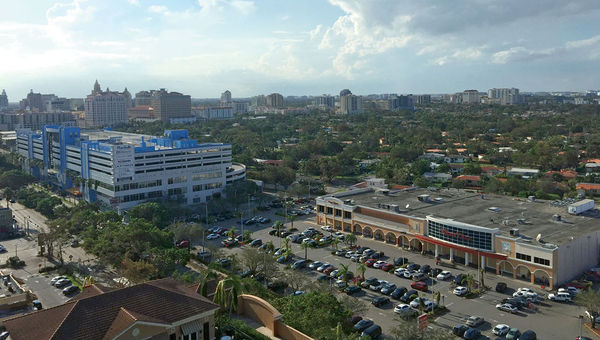MIAMI BEACH -- On Saturday, Sept. 9, when I woke up at a
friend's house in Orlando, where I had sought refuge from Hurricane Irma as it
headed for my home in Key Largo, I saw some interesting news.
Over the previous 24 hours, the storm's path had veered
west, leaving Miami out of the direct strike zone, known to many as the cone of
uncertainty. Suddenly, the modeling showed Tampa as the most likely mainland
Florida city to take a direct hit from the storm, and Orlando itself faced the
possibility of a Category 2 strike.

Robert Silk
In short order, with Irma's outer bands already beginning to
work their way into South Florida, I decided to drive 235 miles back to Miami,
where I also had a place to stay, to ride out the storm there. If Irma didn't
hit Key Largo too badly, I reasoned, I could be back home by Monday morning,
beating the traffic that I knew would develop as millions of evacuees began
working their way back to South Florida from points north.
My back-and-forth moves were unusual only in that I
evacuated south.
But in fact, many friends in Miami and the Upper Keys
evacuated to more than one location as Irma proved to be a fickle storm.
One Miami friend, for example, headed first to his mother's
home in Sarasota, then, as Irma shifted west toward there, headed for Alabama.
A Key Largo friend bounced along the Southwest Florida coast
with her young family before hunkering down in an Orlando hotel.
Another friend evacuated from Key Largo to Tampa and decided
to stay there, but in a phone conversation as I headed back to Miami, he told
me, "What an idiot I am, evacuating right into a hurricane."
Such stories illustrate the exceeding complexity of
emergency management in the face of a hurricane. And nowhere that I know of
within the U.S. is that complexity more impossible than in the Florida Keys,
where just one highway connects the 130 miles between the mainland and Key
West.
But this was my 14th hurricane season in Key Largo, and in
those years I've learned some important strategic lessons. The first is that
with just 30 miles separating me from the mainland, there is little reason for
me to evacuate more than 12 hours before tropical storm-force winds arrive.
Waiting allows for a far more informed decision based on the
track of the storm. I just need to know to where I will evacuate, make sure I
have plenty of fuel and be confident that my car is in good working condition.
Further, waiting virtually ensures that I won't face traffic, since most
everyone else will have left earlier.
This time, I violated my own personal protocol, and I
regretted it.
But in the world of emergency management, things are far
from that simple. Authorities in the Florida Keys in particular have to get
people moving early. It's the only way to marshal 75,000 residents and large
numbers of tourists up that single roadway and to ensure that the evacuation is
orderly.
Imagine the chaos and panic that would arise in a 130-mile
traffic jam with a storm just a day away. And, of course, once people reach the
mainland, they face the possibility of hitting more traffic as they join
potentially millions of drivers fleeing from the Miami, Fort Lauderdale and
West Palm Beach areas.
Knowing all this, the Keys' Monroe County called a mandatory
tourist evacuation on the morning of Sept. 6, four days before Irma made
landfall; residents were required to leave the island that evening.
At the time of the tourist evacuation, Irma was roughly in
the vicinity of Puerto Rico, and all of Florida as well as significant swaths
of water in the Atlantic and the Gulf of Mexico remained in the cone. Key Largo
was right in its center.

The view days after the storm from the Gables Marquis condo building in Coral Gables, Fla. The Winn-Dixie supermarket on the right reopened and, judging by the parking lot, was busy.
Digressing for a moment, I have to note that the term "mandatory"
is something of a misnomer in these evacuations. Responsible hotels typically
heed the orders; they could potentially face repercussions from authorities if
they don't. But I've never known the authorities to force a resident to leave
the Keys, so it's actually a mandatory order that people are free to ignore.
Many in the Lower Keys made just that mistake with Irma, but
ignoring such an order isn't always a mistake. I ignored an evacuation order
for Hurricane Ivan in 2004, and it barely even rained in Key Largo.
These days, however, hurricanes are far from just local
events. In the case of Irma, near nonstop media attention had commenced by the
time of that evacuation order. Millions of people thousands of miles away
frankly find following the path of a hurricane high entertainment, the
anticipation not much different from the buildup to a big game.
So as television anchors echoed official terms like "mandatory"
and warnings like "get out now," the danger, real as it was, took on
a hyperbolic dimension.
I like to believe I handle hurricane threats by being
sensible but not rash. But who in, say, Kansas, can possibly believe someone is
being sensible in waiting when every TV newscast warns that waiting can be
deadly?
As it turned out, my decision to go back to Miami from
Orlando was neither the right one nor the wrong one. Irma did strike Miami with
a bit more force than it struck Orlando, but in the building where I rode out
the storm on the 17th floor, I never felt any danger.
I feel equally ambiguous about whether I should have
evacuated at all.
When I was allowed back into Key Largo two days after Irma,
I found that my home, as I had expected, was fine. I live on stilts and on the
bay side of the island. Most of the heavy Key Largo damage was caused by the
storm surge on the Atlantic side.
Seventy miles south, where Irma made landfall in the Lower
Keys as a Category 4 storm, things were much worse, as attested to by the
horrific images that have since made their way onto TV screens everywhere.
From the standpoint of overall public interest, emergency
management officials had every reason to call for an early evacuation of the
Keys ahead of Irma. Even if the storm had missed the Keys, their decision would
have been more than justified.
For me personally, what had seemed like a good idea on a
Thursday night, when models showed the hurricane crashing straight into Key
Largo, felt different 36 hours later, when models showed a somewhat weaker
storm making landfall on Key West, 100 miles away.
But my dirty little secret, frankly, is that I find
hurricanes to be exciting. I watched and listened to winds swirl from my perch
in Miami and found myself in awe of the storm's raw power. Had I been home in
Key Largo, I might have seen the storm suck dry portions of Florida Bay -- for one-third of my life, I have lived a few hundred yards from there.
Scary? Sure. But wow!